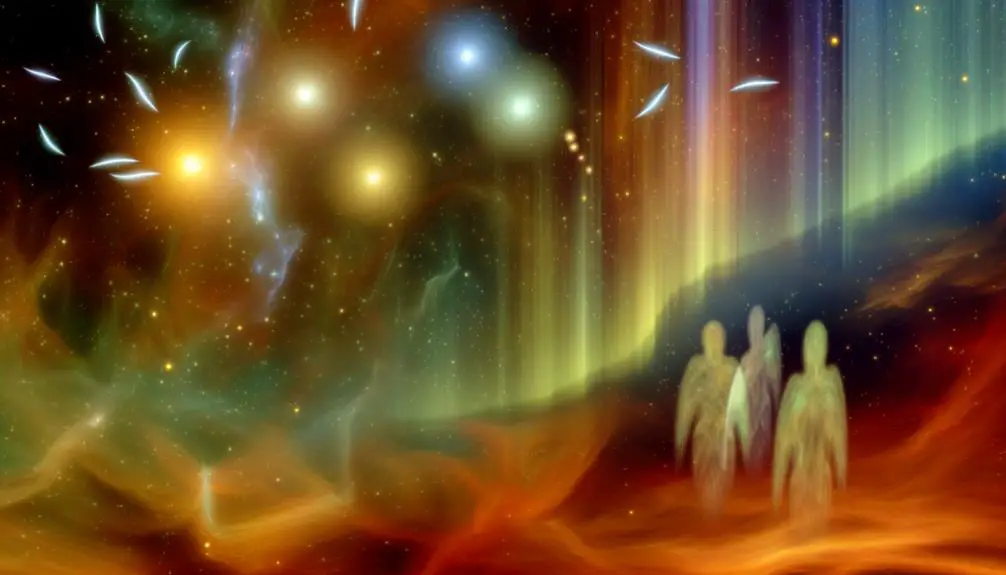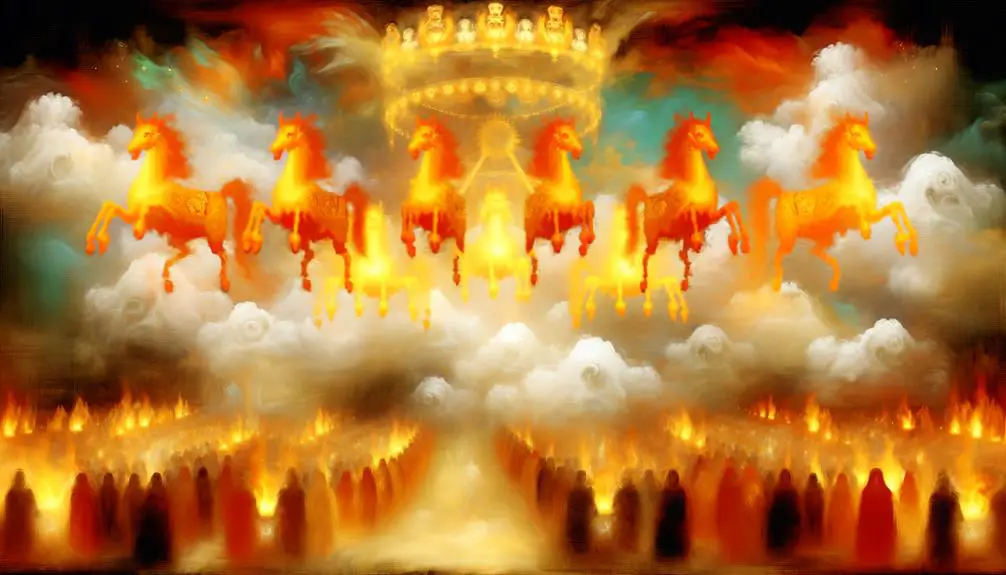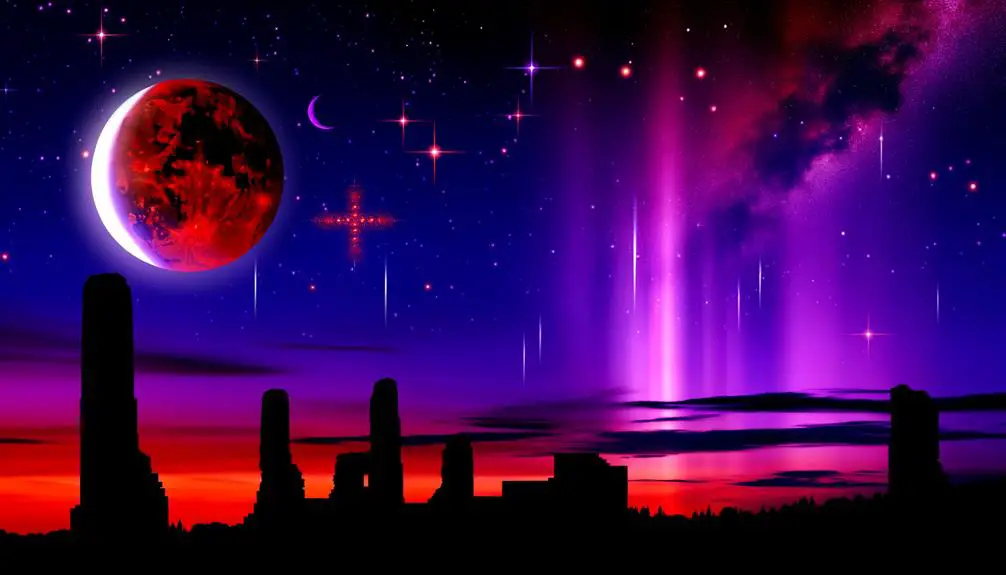Curious about the mysterious celestial signs in the Bible? Discover their prophetic significance and impact on faith across ages.

Strange Things in the Sky Bible Verse
Did you know that approximately one-third of the Bible is dedicated to prophecies, many of which involve extraordinary signs in the skies? These celestial phenomena have intrigued scholars and believers alike for centuries, offering a glimpse into the divine and the prophetic.
From fiery chariots to mysterious visions, the accounts are as fascinating as they are bewildering. You're likely curious about how these ancient texts correlate with modern interpretations and what they may signify for our future.
Let's embark on a journey to uncover the meanings behind these enigmatic sightings and their lasting impact on faith and culture.
Key Takeaways
- Biblical texts often interpret celestial events as signs from God or messages to humanity.
- Prophetic sky signs include unusual planetary alignments, comets, and eclipses, symbolizing divine messages or warnings.
- Scriptural interpretations of sky phenomena blend astronomical knowledge with theological insights, enriching faith and understanding.
- Modern interpretations of strange sky events continue to influence faith journeys, balancing scientific explanations with biblical symbolism.
Origins of Sky Phenomena

Throughout history, humans have looked to the sky, witnessing phenomena that have sparked curiosity, fear, and awe, leading to varied interpretations grounded in the cultural and scientific knowledge of the time. You've probably marveled at the sudden streak of light across the night sky or felt a chill as daylight dimmed unexpectedly. These experiences, often involving meteor showers and solar eclipses, have been pivotal in shaping human understanding and reaction to celestial events.
Meteor showers, the fiery tears of comets past, have danced across the heavens since time immemorial. Ancient civilizations perceived them as omens, either foretelling disaster or heralding divine messages. This interpretation hinged on the cultural context, with some societies celebrating their appearance, while others prepared for doom. The scientific basis, that they result from Earth passing through comet debris, demystifies these spectacles without diminishing their awe-inspiring beauty.
Solar eclipses, on the other hand, caused a different kind of stir. The sudden darkness during a solar eclipse could plunge societies into fear, with many interpreting it as the wrath of the gods. This reaction underscores a fundamental human instinct to find meaning in the inexplicable. Yet, as you delve deeper, you'll find that these events are predictable celestial mechanics at play, where the moon casts its shadow over Earth, temporarily obscuring the sun's light.
Your understanding of these phenomena evolves with the accumulation of scientific knowledge. However, the initial wonder and fear these sky events inspired reveal much about human nature's quest to find order in the cosmos.
Fiery Chariots Explained

Building on our exploration of celestial phenomena, let's now examine the mythic imagery of fiery chariots in the sky, often depicted in ancient texts and art. This motif, intriguing in its persistence and vividness, invites a deep dive into both chariot technology of the past and the historical sightings that might've inspired these narratives.
Fiery chariots have been a staple of human mythology, symbolizing divine intervention, celestial travel, and sometimes, apocalyptic warning. These narratives, while fantastical, may actually be grounded in the technological and astronomical knowledge of the times.
- Chariot technology evolution: Ancient chariots weren't merely terrestrial vehicles but were imbued with symbolic significance, representing speed, power, and the divine. Their depiction as 'fiery' amplifies these attributes, suggesting a technology or force beyond human understanding.
- Historical sightings of comets and meteors: These celestial events, awe-inspiring and sometimes frightening, could easily be interpreted as fiery chariots racing across the sky, especially from the perspective of ancient civilizations.
- Artistic and literary depictions: These often serve to bridge the gap between the earthly and the divine, with fiery chariots acting as conveyances for gods or spirits, signifying their otherworldly origin.
- Psychological interpretation: The fiery chariot can be seen as a metaphor for transcendence, spiritual journeying, or divine wrath, reflecting the collective unconscious of humanity.
- Cultural significance: Across different cultures, the fiery chariot maintains a role as a symbol of divine message or intervention, illustrating a universal human fascination with the skies and what lies beyond.
In this light, the fiery chariots of ancient lore aren't just simple stories but complex interweavings of technology, astronomical events, and deep-seated human beliefs.
Celestial Visions Uncovered

You'll find that celestial visions, often depicted as angelic appearances or prophetic sky symbols, hold profound significance within biblical texts. These elements aren't merely ornamental; they serve as critical conveyors of divine messages and eschatological signs.
Analyzing these occurrences provides insight into the complex interplay between the divine and the mortal, challenging us to reconsider our understanding of biblical prophecy and revelation.
Angelic Appearances Explained
Angelic appearances in biblical texts often symbolize divine intervention or messages, providing insight into the celestial realm's interaction with humanity. These encounters with winged messengers aren't just awe-inspiring; they're deeply meaningful, serving as divine interventions in critical moments.
- Winged Messengers: Angels are frequently depicted as winged beings, symbolizing their role as divine messengers between heaven and earth.
- Divine Interventions: Angelic visits often precede significant events, indicating God's direct involvement.
- Guidance: Angels provide guidance, delivering God's wisdom to individuals in need.
- Protection: They're also protectors, shielding people from harm.
- Revelation: Through angels, God reveals future events, providing warnings or prophecies.
Understanding these celestial visits helps you grasp the depth of God's engagement with His creation.
Prophetic Sky Symbols
Having explored how angels serve as divine couriers, we now turn our attention to the skies themselves, where celestial visions often carry profound prophetic significance. These visions, manifesting as star patterns and eclipse symbolism, serve as divine messages, guiding or warning humanity. Let's delve into this fascinating aspect.
Celestial Phenomenon |
Prophetic Significance |
|---|---|
Star Patterns |
Often interpreted as signs of significant births or events, guiding those who understand their meanings. |
Eclipse Symbolism |
Viewed as omens of change, eclipses can signify divine discontent or the marking of a monumental event. |
Comet Appearances |
Historically seen as heralds of doom or great change. |
Planetary Alignments |
Believed to indicate significant divine interventions or shifts in power. |
Meteor Showers |
Can symbolize the fleeting nature of life or foretell rapid changes. |
Analyzing these symbols, you're engaging with a tradition of seeking divine wisdom in the heavens.
Prophetic Sky Signs

You must first recognize the importance of prophetic sky signs as depicted in biblical texts, which serve as a cornerstone for interpreting celestial events. Understanding the historical context of biblical sky phenomena allows for a deeper insight into their significance both in ancient and modern times.
Connecting these ancient observations with contemporary interpretations necessitates a critical analysis of scripture, challenging you to discern the relevance of these signs in today's world.
Identifying Prophetic Sky Signs
Throughout history, biblical texts have described prophetic sky signs, suggesting that celestial events often serve as divine messages to humanity. Identifying these signs involves discerning the cosmic warnings and astronomical anomalies that stand out from ordinary celestial patterns.
To recognize these prophetic signs, consider:
- Unusual alignments of planets and stars
- Sudden appearances of comets or meteors with significant timing
- Eclipses occurring alongside key biblical festivals
- Unique atmospheric phenomena linked to prophetic scripture
- Patterns in the stars that mirror biblical symbols or narratives
Interpreting these signs requires a blend of astronomical knowledge and scriptural insight. They aren't mere coincidences but are believed to be messages, forewarning, or affirmations of divine will, urging humanity to reflect, prepare, or act in accordance with spiritual teachings.
Biblical Sky Phenomena Interpretation
To accurately interpret biblical sky phenomena as prophetic signs, one must delve deeply into both scriptural texts and astronomical observations, discerning the divine messages woven within. The Bible references various cosmic anomalies, often attributed to supernatural explanations, signaling God's power and foretelling future events. These narratives, rich with symbolic meaning, require a nuanced understanding of ancient cosmology and theology.
For instance, the appearance of a star signaling the birth of Jesus combines historical astronomical knowledge with a profound theological message. Similarly, prophetic books like Revelation describe visions of the heavens that challenge our comprehension, blending celestial phenomena with eschatological promises.
Interpreting these signs isn't about predicting the future but understanding God's communication through the cosmos, where natural and supernatural realms meet.
Modern Observations and Scripture
As we examine modern celestial events through the lens of scripture, it becomes evident that prophetic sky signs continue to hold significant theological implications. The intersection of UFO debates and astronomical anomalies with biblical prophecy invites a complex, scholarly analysis.
Here's what you need to consider:
- UFO debates often intersect with eschatological themes, challenging traditional interpretations.
- Astronomical anomalies, once considered divine signs, are now scrutinized through both scientific and theological lenses.
- Scriptural references to celestial signs are re-evaluated in the light of modern discoveries.
- The role of prophecy in interpreting contemporary sky phenomena is increasingly significant.
- This discourse enriches our understanding of divine messages, urging a nuanced approach to modern observations.
Divine Encounters Described

The Bible's narrative offers vivid descriptions of divine encounters, showcasing profound interactions between the divine and humanity. These stories, rich in symbolism and meaning, serve as foundational texts for understanding how the divine communicates through extraordinary means. You'll find that mystical flights and divine messages frequently emerge as themes, representing not just the physical ascension or journey but also the spiritual elevation of those who experience them.
Mystical flights, for example, are depicted in accounts such as Elijah's ascent into heaven in a whirlwind or Enoch's translation from earth to the divine presence. These narratives aren't merely about the physical act of moving from one realm to another; they symbolize the profound spiritual journeys and transformations these individuals undergo. The emphasis here is on the transcendence of the ordinary, a leap into a realm of divine reality that defies mundane existence.
Divine messages, on the other hand, often come through unexpected or miraculous means, such as burning bushes, dreams, or even direct angelic visitations. These messages serve as a direct line of communication from the divine to humanity, offering guidance, warning, or revelation. The mode of delivery underscores the importance of the message itself, elevating it above everyday communication to underscore its sacred significance.
Analyzing these encounters, you'll notice they're not just historical or mythological anecdotes. They're deeply symbolic narratives that explore the relationship between the divine and humanity, revealing a world where the sacred interacts with the mundane, where human beings are called to something greater than themselves through mystical flights and divine messages.
Interpreting Heavenly Events

Interpreting heavenly events within biblical narratives invites you to consider how these extraordinary occurrences convey deeper spiritual meanings and divine intentions. These moments, often marked by what could be described as meteorological misunderstandings or astronomical anomalies, challenge you to delve into the rich symbolism and prophetic messages embedded within the scriptures. The task isn't merely to recount these wonders but to unravel the layers of interpretation that they embody.
To aid in your exploration, consider the following points:
- Contextual Analysis: Understanding the historical and cultural context of these events can illuminate their significance. For instance, a comet that might be seen as an ominous sign in one culture could be interpreted very differently in another.
- Symbolic Interpretation: Many heavenly events serve as metaphors or symbols. A blood-red moon mightn't just be an astronomical anomaly but a symbol of divine wrath or significant change.
- Prophetic Significance: Some events are depicted as fulfillments of prophecy, serving as divine confirmations of God's promises or warnings.
- Literal vs. Figurative: Distinguishing between what's meant to be understood literally and what's figurative language can be challenging but is crucial for accurate interpretation.
- Cross-Reference with Scientific Understanding: Aligning biblical descriptions with current astronomical knowledge can help clarify what these events might've been, separating historical fact from metaphorical or prophetic content.
Engaging with these aspects encourages a deeper, more nuanced understanding of biblical texts, where meteorological and astronomical events aren't just historical footnotes but rich, symbolic narratives conveying divine messages and intentions.
Impact on Faith and Culture
Heavenly phenomena, as recounted in biblical narratives, have profoundly influenced both individual faith journeys and broader cultural perceptions throughout history. These occurrences, often interpreted as divine signs, haven't only strengthened believers' faith but have also been pivotal in the cultural integration of religious beliefs. As you delve into the scriptures, it's clear that celestial events have served as touchstones for theological reflection and spiritual awakening.
However, the rise of astronomical skepticism has posed challenges to traditional interpretations of these phenomena. This skepticism, fueled by advances in scientific understanding, encourages a reevaluation of how these events are perceived and their impact on faith. You're prompted to question, to seek deeper meanings beyond the literal interpretations of the past. This shift doesn't diminish the significance of these biblical events; instead, it invites a richer, more nuanced engagement with the text.
Cultural integration of these biblical accounts has been both complex and multifaceted. On one hand, these stories have been woven into the fabric of societal norms and values, shaping moral and ethical codes across generations. On the other, they've sparked dialogue and debate, bridging divides between faith and reason, tradition and innovation. You're witnessing a dynamic interplay between enduring beliefs and contemporary skepticism, a testament to the enduring power of these ancient narratives to inspire, challenge, and transform.
In essence, the intersection of faith, culture, and astronomical skepticism surrounding strange things in the sky as described in the Bible illustrates a vibrant, ongoing conversation. It's a conversation that invites you to explore, question, and ultimately deepen your understanding of the divine and the cosmos.
Frequently Asked Questions
How Have Modern Scientific Discoveries and Technology Altered Our Understanding of the Phenomena Described in the Bible as "Strange Things in the Sky"?
Modern scientific discoveries, particularly astronomical advancements, have dramatically shifted your interpretation of sky phenomena. You're now equipped with tools that demystify what once seemed supernatural.
The technological skepticism you apply to biblical descriptions challenges traditional narratives. Understanding natural explanations for celestial events, you view these accounts through a critical, analytical lens.
This perspective fosters a deeper appreciation for the ancient texts, while acknowledging the vast knowledge gained through science.
Can Parallels Be Drawn Between the Biblical Descriptions of Sky Phenomena and Similar Accounts in Other Ancient Religions or Mythologies?
Sure, let's pretend ancient skies were just a celestial reality show, starring gods and monsters for entertainment.
But seriously, you can indeed draw parallels between biblical sky phenomena and similar tales in other ancient religions.
These celestial myths, rich with cultural symbolism, serve as a fascinating study.
Analyzing them, you'll find a shared human experience, interpreting the heavens in ways that reflect the fears, hopes, and imagination of our ancestors across different cultures.
What Role Do Psychological or Sociological Factors Play in the Interpretation and Significance of Sky Phenomena in Biblical Times Compared to Today?
You're exploring how psychological and sociological factors influence the interpretation of sky phenomena. Cultural symbolism and emotional responses play key roles.
In biblical times, these phenomena often bore deep religious significance, shaping societal beliefs and behaviors. Today, while you might understand these events through science, the emotional impact and cultural symbolism still affect perceptions.
This shift reflects changes in societal values and knowledge, emphasizing the evolving nature of human understanding and emotional engagement with the sky.
Are There Any Documented Instances Where Strange Sky Phenomena Predicted in the Bible Have Been Directly Linked to Specific Historical Events or Periods?
You're exploring whether historical eclipses, meteor showers, or other sky phenomena have been directly linked to specific events or periods as predicted in biblical texts.
While scholars analyze these connections, it's challenging to conclusively tie specific astronomical events to biblical prophecies due to the interpretative nature of these texts and the historical context required.
However, studies of ancient texts and astronomical records can offer insights, though definitive correlations remain elusive.
How Do Skeptics and Non-Religious Scholars Interpret These Biblical Accounts of Strange Things in the Sky, and What Alternative Explanations Do They Offer?
You'll find skeptics and non-religious scholars often interpret these accounts through the lens of ancient astronomy and mythological symbolism. They suggest that what's described as divine or supernatural phenomena could be natural celestial events, understood and recorded within the knowledge and cultural context of the time.
These interpretations provide alternative explanations, focusing on how ancient societies made sense of the world around them, without necessarily attributing these events to divine intervention.
Conclusion
As you've journeyed through the mysteries of the sky, consider the ancient tale of a lone shepherd witnessing a meteor shower; a celestial dance that whispers of the universe's vastness and the divine. This story, much like the biblical verses, serves as a metaphor for human curiosity and our quest for understanding.
Analyzing these heavenly phenomena not only deepens our faith but also enriches our cultural tapestry, reminding us that the sky above is a complex narrative woven with divine and prophetic significance.



Sign up